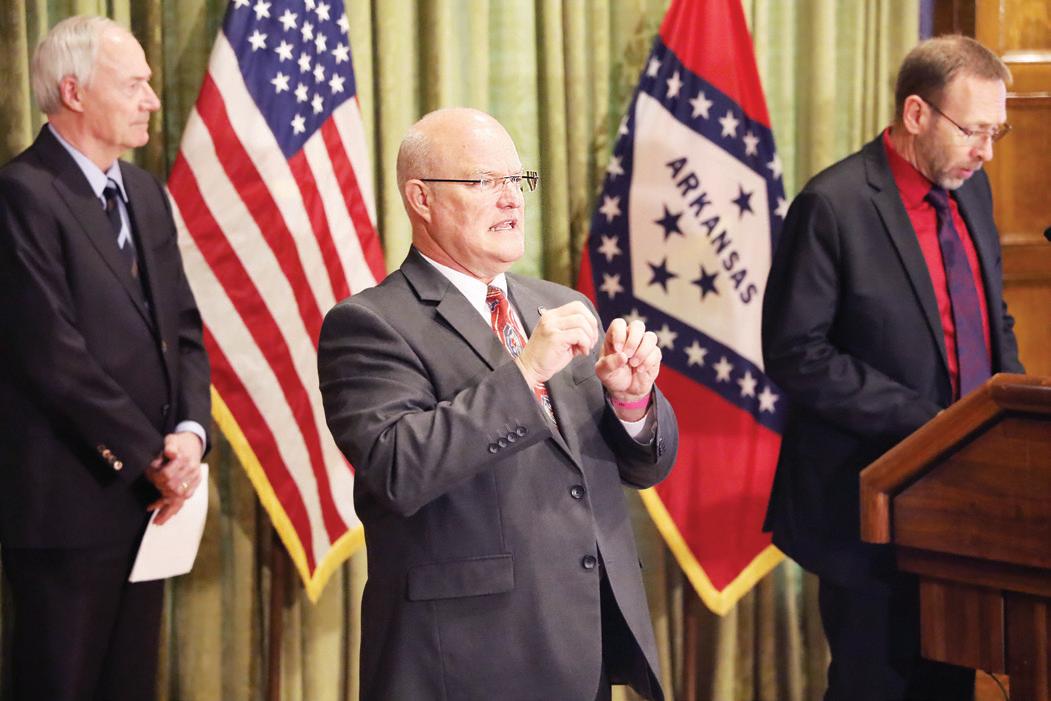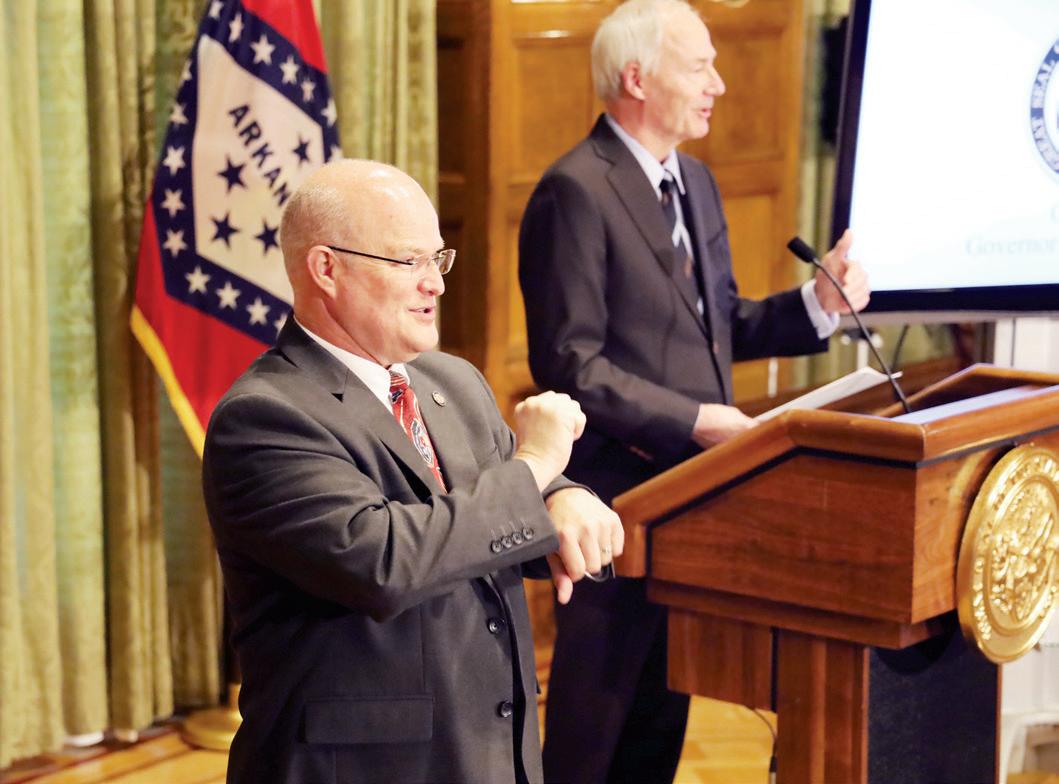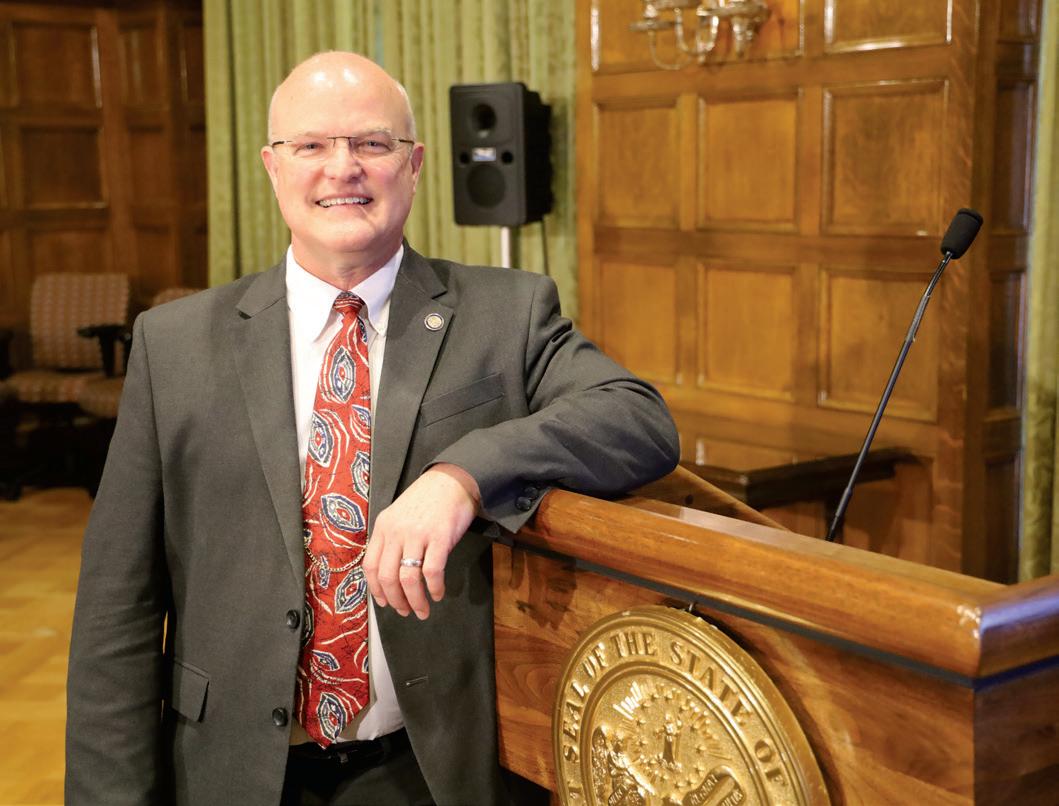
6 minute read
Eddie and the Hand Jive
Eddie Schmeckenbecher
Words and images Dwain Hebda
Love makes you do strange things; takes you places you might not have expected you’d go and shows you sights you may never think you’d see. For Eddie Schmeckenbecher, communications specialist for Arkansas School for the Deaf, love and American Sign Language go, quite literally hand-in-hand. L
“I started learning (to sign) at church in 1972. They had a deaf ministry at church and I thought it was fascinating to watch the interpreter,” he says. “I was in high school. There was a girl that was an interpreter. You know, there’s always a girl involved somewhere.”
While the romance part didn’t materialize, Eddie’s love affair with signing and the people who benefited from his ministry stuck. Throughout his college years, split between Liberty Baptist College (now Liberty University) in Lynchburg, Virginia, and UA Little Rock, he continued to hone his technique, taking formal courses and interpreting church services and classes for the academic and spiritual enrichment of the deaf.
“While I was at Liberty Baptist College, they asked me if I would interpret a class for deaf students. I said sure. I’d been interpreting for about five years in church,” he says. “So, I started doing it and they paid me me for interpreting in a class. I thought well, this is pretty cool. Now that I’ve done it for forty-something years, it’s become second nature to me.”
Two years ago, Eddie was summoned by his boss at the Arkansas School for the Deaf for a meeting. The governor’s office was in need of a sign language interpreter for press conferences and other events and he was being assigned to the job. He was happy to do it, even if he wasn’t given much choice in the matter.
“The governor talked with the superintendent (about having an interpreter), and the superintendent said, yes we can help – ‘Eddie, you go and interpret,’” he recalls with a chuckle.
So began what was initially an innocuous assignment with the governor’s office, that is, until 2020 and the COVID-19 pandemic reached Arkansas. As Governor Asa Hutchinson’s daily press conferences became must-see TV for a population locked into their homes, many viewers were drawn to the man to the left of the podium, captivated by his bright neckties, fluid signing and animated facial expressions.
“Typically, I’m in a box in the bottom of the screen, I’m not standing up beside him,” Eddie says. “But because there are unprecedented times, they decided to have the interpreter stand up beside the governor.”
As a result, Eddie’s audience, as well as his notoriety, leapt exponentially. By the end of April, Eddie was a full-blown social media star, attracting press interviews and inspiring hundreds of comments from onlookers across the state.
“He is the most professional interpreter I have ever seen,” writes Gigi on Facebook. “Thinking I’m actually learning some signs from him. I listen to the governor but watch him,” adds Myra.
“My daughter currently takes ASL in high school. Eddie is helping her stay well practiced,” writes Melissa, one of many similar such sentiments. “Thank you, Eddie, for being a kind human.” Watching Eddie work is a thing of beauty. For those blessed with your hearing, cover your ears or turn down the volume for a few minutes and watch. The fluid motions may hold no meaning, but even those uninitiated in ASL are drawn by the animated body language and expressions. Before you know it, slivered rays of meaning begin to shine.
It’s a comment Eddie hears over and over from ASL neophytes, but it's not mere performance art. Mouthing the words helps a deaf person who may be accustomed to reading lips and expressions assign the context that the hearing use vocal tone and pitch to convey in conversation.
“The word ‘understand’ for example,” says Eddie, “I can sign that word and then with different facial expressions it can be, ‘I understand,’ ‘I don’t understand,’ or ‘Do you understand?’ Just by changing my facial expressions, not changing the sign, all of those sentences come from that one sign.”


The most remarkable thing about watching Eddie work is when you notice how well he keeps up with the speaker, despite the fact that he’s had no preview of what’s to be said. His method is a complicated and well-worn equation of hear-comprehendtranslate-sign that’s only one or two beats behind the actual speaker, despite the fact that syntax between the languages doesn’t align perfectly.
“(ASL is) a completely different language (from English). Actually, the grammar structure for ASL is more related to Spanish and French,” he says. “If I said, ‘I painted the house red yesterday,’ if I was signing that, I would say, ‘Yesterday house me paint red.’ In order to do true ASL I have to give a little bit of time lag to figure out what they’re saying before I can put it in ASL.
“For example, when I hear the word ‘run’ there are in the dictionary about two hundred fifty-six different meanings for the word. Well, for all of those there are different signs. It’s not just one word, one sign. So, I have to get the meaning of the word before I can sign it.” Throw in unfamiliar name spellings, most of which have to be spelled out one letter at a time, and the inevitable (and very occasional) error he must back up and correct, and Eddie’s unflappable expertise becomes nothing short of astonishing.
“If you said ‘My name is Dwain Hebda’ I would go back to my reference of the word ‘Dwain’ and then ‘Hebda’,” he says. “I would tend to finger spell it like I hear it. It may be right, it may be wrong. But I get the word out.
“I try to finger spell at a pace that people are able to understand; I could spell ‘Schmeckenbecher’ pretty fast, but I have to slow it down a little bit.”
Eddie says interpreting Gov. Hutchinson is relatively easy given the chief executive’s moderate pace of speaking. And, the format of a press conference where generally only one person is talking at a time, is also easier than what he does in his day job, such as interpreting eighteen people in two-way communication on a forty-five-minute video call.
“Right now, we’re doing meetings for school and we have parents, teachers, students all on the Zoom call,” he says. “I’m interpreting for everybody, whether they’re hearing or

whether they’re deaf. I have to signify who’s speaking by giving their name or their sign name or ‘mother’ or ‘father.’
“When the deaf person speaks on a call like that or even in a meeting, I say their name and voice for them what they’re signing in order for somebody in the room who doesn’t know sign language to understand. I’m working for forty-five minutes straight, interpreting both ways. I don’t get a break.”
Eddie’s technical precision has come by way of perfecting his gift for decades. But it’s the love and care with which he communicates, radiating through him to the audience, that truly sets him apart. It’s what drew deaf congregants to gather at his home after church services as a teen and guided him in his previous work as a rehab counselor to the deaf. And today, it’s what informs and inspires thousands – deaf and hearing alike – who tune in to gain information and hope through the governor’s COVID-19 broadcasts. Love, it seems, has a very long shelf life.
“What I like about what I do is, getting out and meeting different people, getting in different situations,” he says. “My favorite places to interpret are church, hospital operating rooms and funerals. There have been people that request me specifically for interpreting for them. That’s really meaningful.”












